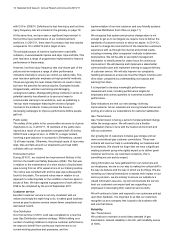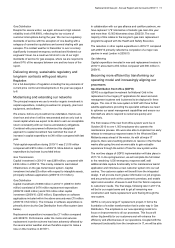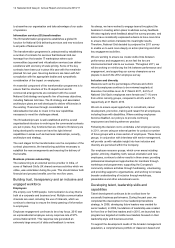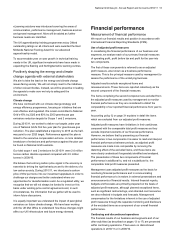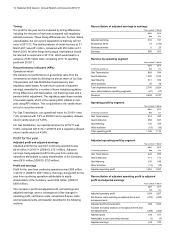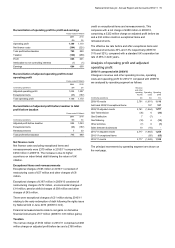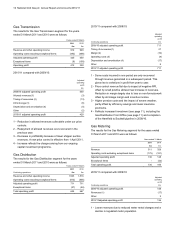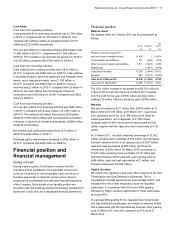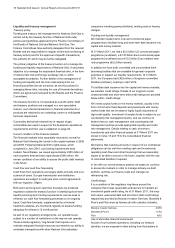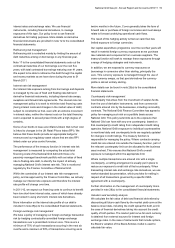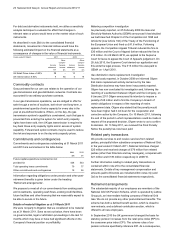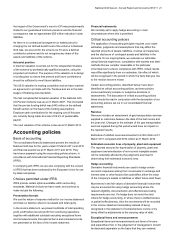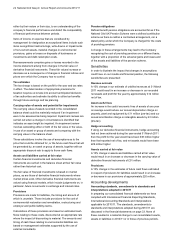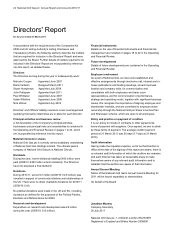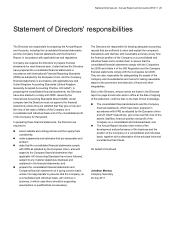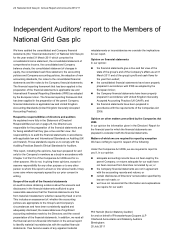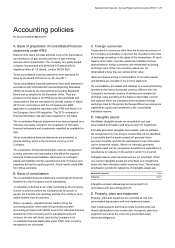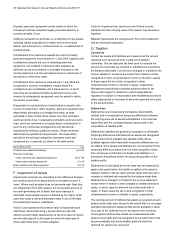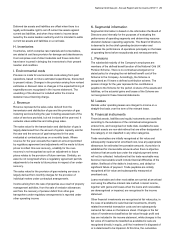National Grid 2011 Annual Report Download - page 21
Download and view the complete annual report
Please find page 21 of the 2011 National Grid annual report below. You can navigate through the pages in the report by either clicking on the pages listed below, or by using the keyword search tool below to find specific information within the annual report.National Grid Gas plc Annual Report and Accounts 2010/11 19
interest rates and exchange rates. We use financial
instruments, including financial derivatives, to manage
exposures of this type. Our policy is not to use financial
derivatives for trading purposes. More details on derivative
financial instruments are provided in note 12 to the consolidated
financial statements.
Refinancing risk management
Refinancing risk is controlled mainly by limiting the amount of
debt maturities arising on borrowings in any financial year.
Note 17 to the consolidated financial statements sets out the
contractual maturities of our borrowings over the next five
years, with total contracted borrowings maturing over 41 years.
We expect to be able to refinance this debt through the capital
and money markets as we have done during the year to 31
March 2011.
Interest rate risk management
Our interest rate exposure arising from borrowings and deposits
is managed by the use of fixed and floating rate debt and
derivative financial instruments, including interest rate swaps,
swaptions and forward rate agreements. The interest rate risk
management policy is to seek to minimise total financing costs
(being interest costs and changes in the market value of debt)
subject to constraints so that, even with an extreme movement
in interest rates, neither the interest cost nor the total financing
cost is expected to exceed preset limits with a high degree of
certainty.
Some of our bonds in issue are inflation-linked, that is their cost
is linked to changes in the UK Retail Prices Index (RPI). We
believe that these bonds provide an appropriate hedge for
revenues and our regulatory asset values that are also RPI
linked under our price control formulas.
The performance of the treasury function in interest rate risk
management is measured by comparing the actual total
financing costs of the National Grid debt with those of a
passively managed benchmark portfolio with set ratios of fixed
rate to floating-rate debt, to identify the impact of actively
managing National Grid’s interest rate risk. This is monitored
regularly by the Finance Committee of National Grid.
Within the constraints of our interest rate risk management
policy, and as approved by the Finance Committee, we actively
manage our interest rate exposure and therefore the interest
rate profile will change over time.
In 2011/12, we expect our financing costs to continue to benefit
from low short-term interest rates, some of which have already
been locked in using short-term interest rate derivatives.
More information on the interest rate profile of our debt is
included in note 28(a) to the consolidated financial statements.
Foreign exchange risk management
We have a policy of managing our foreign exchange transaction
risk by hedging contractually committed foreign exchange
transactions over a prescribed minimum size. This covers a
minimum of 75% of such transactions occurring in the next six
months and a minimum of 50% of transactions occurring six to
twelve months in the future. Cover generally takes the form of
forward sale or purchase of foreign currencies and must always
relate to forecast underlying operational cash flows.
The result of this hedging activity is that our cash flow has
limited exposure to foreign currencies.
Our capital expenditure programme over the next few years will
result in material foreign currency exposures as we purchase
raw materials and components from overseas suppliers. The
treasury function will seek to manage these exposures through
a range of hedging strategies and instruments.
In addition, we are exposed to currency exposures on
borrowings in currencies other than sterling, principally the
euro. This currency exposure is managed through the use of
cross-currency swaps, so that post derivatives the currency
profile is almost entirely sterling.
More details can be found in note 28(a) to the consolidated
financial statements.
Counterparty risk management
Counterparty risk arises from the investment of surplus funds,
from the use of derivative instruments, and from commercial
contracts entered into by the businesses, including commodity
contracts. The National Grid Finance Committee has agreed a
policy for managing such risk on a portfolio basis across
National Grid. This policy sets limits as to the exposure that
National Grid can have with any one counterparty, based on
that counterparty’s credit rating from independent credit rating
agencies. National Grid’s exposure to individual counterparties
is monitored daily and counterparty limits are regularly updated
for changes in credit ratings. The treasury function is
responsible for managing the policy. Where contracts carrying
credit risk are entered into outside the treasury function, part of
the relevant counterparty limit can be allocated to the business
area involved. This ensures that National Grid’s overall
exposure is managed within the appropriate limit.
Where multiple transactions are entered into with a single
counterparty, a netting arrangement is usually put in place to
reduce our exposure to credit risk of that counterparty. When
transacting interest rate and exchange rate derivatives, we use
market standard documentation, which provides for netting in
respect of all transactions governed by a specific ISDA
agreement with a counterparty.
Further information on the management of counterparty risk is
provided in note 28(c) to the consolidated financial statements.
Valuation and sensitivity analysis
We calculate the fair value of debt and financial derivatives by
discounting all future cash flows by the market yield curve at the
balance sheet date, including the credit spread for debt, and in
the case of financial derivatives taking into account the credit
quality of both parties. The market yield curve for each currency
is obtained from external sources for interest and foreign
exchange rates. In the case of instruments that include options,
the Black’s variation of the Black-Scholes model is used to
calculate fair value.



